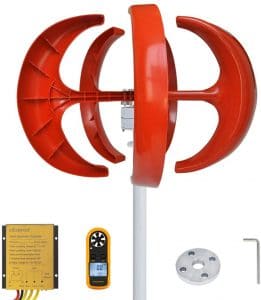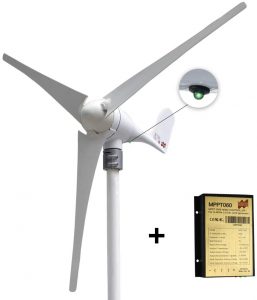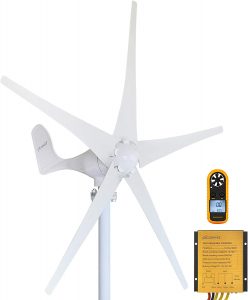Man has been using wind for thousands of years for sailing and milling activities, and this is no surprise to most people. However, wind continues to provide us with numerous advantages even today, in spite of the highly advanced technologies that have taken over and simplified our lives. The same energy that we can harness from the wind can be used to generate clean and fully renewable electricity.
If you are trying to embrace a more sustainable living style, or you are just curious to learn how does wind power work and what are the main pros and cons of wind energy, these next few lines should provide a glance into the fascinating world behind wind energy.
What Is Wind Energy?
Without a doubt, the uncertainty we seem to be living our lives in every day should convince you of the necessity to have to always back backup, in all matters and aspects of your existence, but even more so when it comes to electrical power.
Are you prepared to handle a prolonged power outage at home? Do you think your gas-powered generator will suffice? What about the loud noise it makes, the hard to bear fumes that you are forced to inhaled, or the need to find the most suitable gas storage place, away from your kids and pets? Not to mention the negative impact on the environment, in complete opposition with your newly embraced eco-friendly, green, sustainable lifestyle!
One good alternative in terms of energy, however, is provided by something as simple as the wind. Wind power refers to the process of generating electricity with the help of the wind or naturally occurring flows of air found in the atmosphere. With the help of modern-day wind turbines, the kinetic energy from the wind is harnessed and used to produce electricity.

How Does A Wind Turbine Work?
There are different types of wind energy turbines:
- Utility-scale turbines that can generate between 100 kilowatts to a few megawatts and deliver energy to power grids, sending it to end-users with the help of electric utilities and operators.
- Small wind turbines, also called distributed wind turbines, are small, individual turbines below 100 kilowatts that can power a household, an entire farm or a small-sized business.
- Offshore wind turbines located in larger bodies of water on continental shelves, which are larger compared to land turbines and which can generate larger amounts of power.
Whenever the wind blows past a wind turbine, the blades on it capture the kinetic energy from it and start to rotate, turning the kinetic energy into mechanical energy. This particular rotation movement triggers an internal shaft that is tied to a gearbox, responsible for boosting the rotation speed x100. In turn, this will start to spin a generator that will generate electricity.
Wind turbines are at least 262 feet tall and they are represented by tubular towers made of steel that support hubs featuring 3 blades, as well as a nacelle. The later is responsible for hosting a generator, a gearbox, a shaft, and the necessary controls.
Once the exact measurements of the wind are detected, the turbine will be directed according to the stored information and it will begin its rotative movements, while facing the most powerful wind. This means that its angle and the blades’ pitch will be optimized in such a way so they can harness the biggest amount of energy.
Standard turbines generate electricity whenever the speed of the win reaches 6-9 mph, which is also referred to as the “cut-in” speed. A wind turbine will automatically stop spinning when the wind reaches 55 miles an hour or more, to stop the equipment from suffering any damages.
Throughout a year, a wind turbine is capable of generating electricity over 90 percent of the time. The more powerful the wind, the more electricity is produced.
What Is the Capacity Factor?
This is yet another way of measuring of generation of energy from the wind and it quantifies the amount of electricity generated by a wind turbine produces in a certain timeframe, in relation to its maximum potential.
What is The Difference Between A Windmills And A Wind Turbine?
Oftentimes, people will alternatively use the terms wind turbine and windmill to refer to the same thing. However, there are some significant differences between them. While windmills have been in use for hundreds of years for pumping water or grinding grains, and their main purpose is to produce mechanical energy, they are not able to also generate electricity.
On the other hand, wind turbines are complex devices that count no less than 8,000 parts and which can harness the kinetic energy from the wind and turn it into electricity.
What Are Wind Farms?
A wind farm consists of a number of wind turbines that have been set up next to one another and which works as one large power plant that can generate and send electricity to the grid. From there, the energy will be sent to people’s homes or commercial facilities via electric utilities as well as power operators.
With the help of small distribution lines, the energy generated at the wind farm will be collected and transferred to a larger network of transmission lines. From there, it will be sent over longer distances to those places where it is needed. With the help of smaller distribution lines, the electricity is then directed to towns, households, and business.
What Are The Main Power Wind Advantages and Disadvantages?
Wind Power Advantages
- Wind power is sustainable, eco-friendly, and completely renewable. Wind turbines do not pollute the environment when generating electricity, as there is no greenhouse effect triggered by the simple process.
- Wind energy lowers the need for fossil fuels. Since there is no need to burn any fossil fuels to generate electricity using wind, this is have a good impact on cutting carbon footprints and the toxic impact on nature, while preserving the earth’s most important natural resources such as natural gas, coil, and oil.
- Wind power is readily-available and free of charge.
- The energy from wind turbines can be used by residential and commercial consumers and there are also portable wind turbines that can be carried around and used to power smaller devices in remote locations, while on the go. Wind turbines are also excellent alternatives for smaller villages as well as research facilities located in various parts of the world where connecting to the grid is impossible or too expensive and complicated.
- Wind turbines are cheap to run and maintain. Their upkeep must be done once every few months and the running costs are also low since wind is free. Utility companies must invest in buying, installing, and up-keeping wind turbines and keep taking advantage of this free energy source.
- The potential of wind turbines is undeniably impressive. Wind energy is omnipresent, easy to access and it comes with fewer limitations compared to other than sources of renewable energy.
Cons of Wind Energy
- Wind is not always steady and constant and its fluctuations could cause issues in terms of the turbines’ efficiency. Utility companies are forced to constantly spend money on identifying the best locations are wind farms.
- Wind turbines can get pricey. While the costs are slowly dropping, the turbines continue to cost a lot to be built, especially when it comes to wind farms located offshore.
- Wind turbines can threaten wildlife, especially bats and birds.
- Wind turbines can get extremely loud. They can be heard from a long distance, especially when it comes to wind farms with several wind turbines. Noise pollution from wind turbines is one of the most serious issues that has affected the lives of lots of homeowners.
FAQ
Wind energy is energy generated with the help of the wind or naturally occurring airflows found in the atmosphere. With the help of modern-day wind turbines, kinetic energy from the wind is captured and used to generate electricity.
The capacity factor enables the measurement of the amount of energy generated using the wind and it quantifies the amount of electricity generated by a wind turbine produces in a certain timeframe, in relation to its maximum potential.




